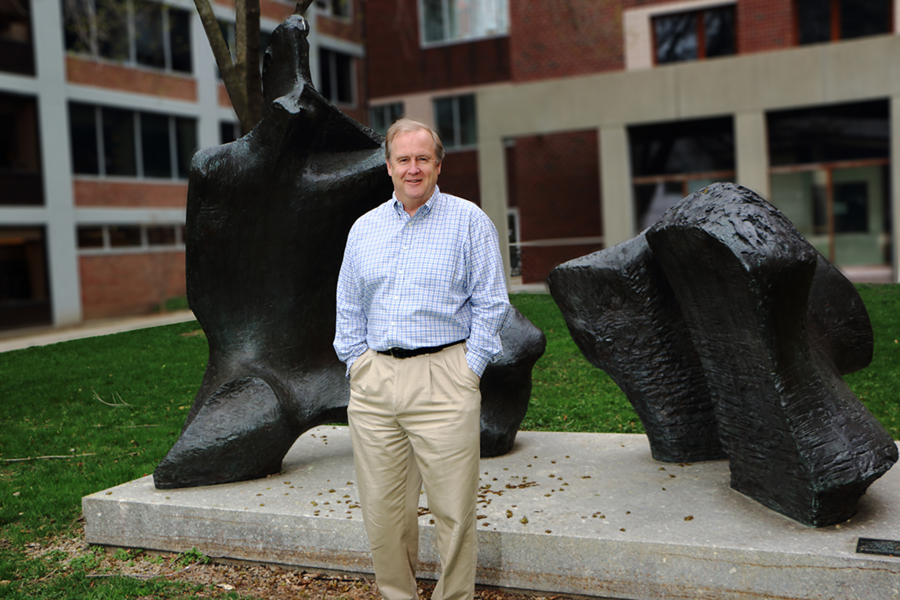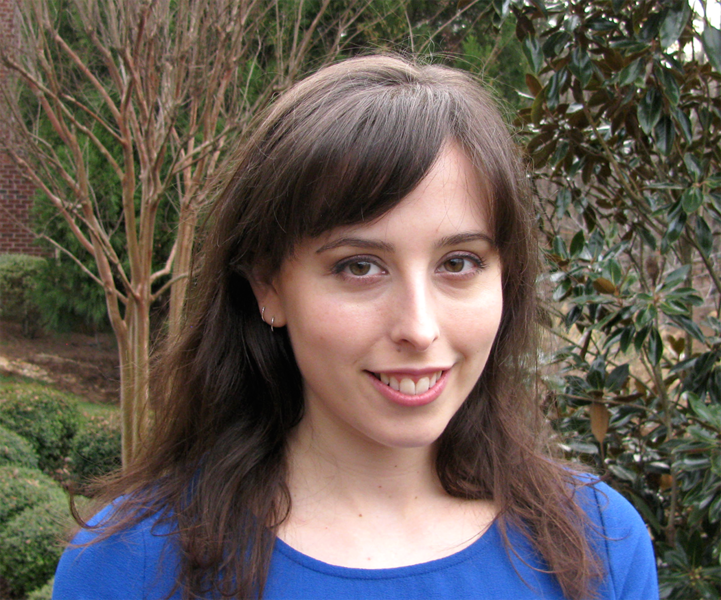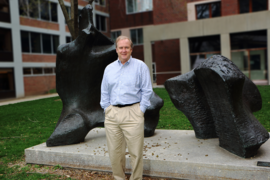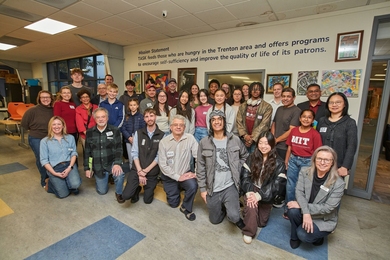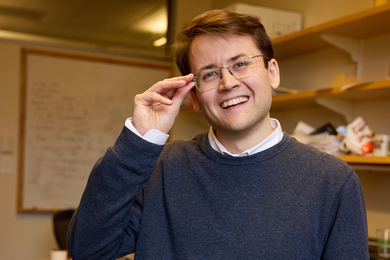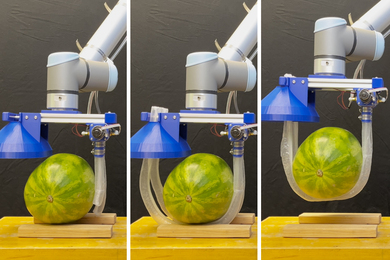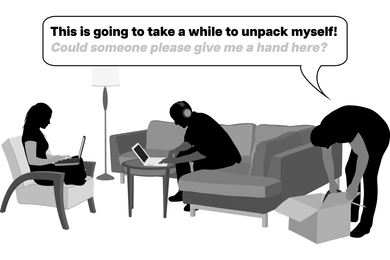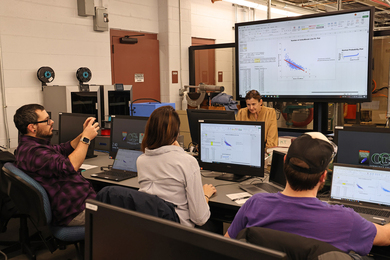In a world where average Web page engagement is often measured in seconds, MIT Professor W. Craig Carter is intentionally slowing down his online course presentation to engage materials science students in a "master class" model built around students interacting with an instructor.
Imagine cellist Yo-Yo Ma holding a master class for a dozen students with another few dozen observing, Carter suggests. "Yo-Yo Ma might play a few notes on the cello and then make comments about those notes, and then he might ask a student, try to repeat that with your own cello," Carter explains. "And so the student will do that. The student inevitably makes a mistake and receives some very kind criticism from Yo-Yo Ma. So the student clearly benefits from that interaction, but the students who are sitting in the room listening to the critique and how the student is doing — the playback — also receive a benefit. That's where real learning takes place; not only is it the theory associated with practicing something, but it's practicing itself."
"The challenge with distance education is how do you put in that kind of practice, and direct critique and gentle criticism, not only by the instructor, but by the other students," he explains.
Carter is incorporating the master class approach in his Materials Science Curriculum (MSC) 2.0 courses, such as 3.017 (Modeling, Problem Solving, Computing, and Visualization), which was taught exclusively online to students at MIT this spring. The course integrates Mathematica notebooks and the Wolfram Language for solving problems. Wolfram business development associate Adriana O'Brien says, "What he's trying to do is really create a platform for learning that engages the students, makes them think in that distance learning environment."
Individual tutorials start by describing the nature of a problem the student must solve and show a visualization of the problem that will be understood at the end. There will be Web resources for further reading and perhaps video. "Then bits of code are presented for the student as kind of prototype method of attacking the problem," Carter says. "So you give the student a little push and a little help, and then you give the student a challenge — go off and solve this sub-problem and try to do it yourself." The student is given a certain amount of time to solve the problem while a proctor stands by. "I sit there and I say here's the challenge problem, I'm going to be quiet for 10 minutes while you give this a shot," he says.
Possible solutions
One of three things can happen, Carter says. "The best outcome is the student tries it and achieves some level of success; the second best is that the student tries it and fails; the third is student doesn't try at all and there is nothing I can do about the third." After the allotted time for problem solving is up, the student is offered a password-encoded prototype solution from an expert. "It's not going to look anything like the solution that the student who solved it got, and it's not going to look anything like the path that the student who didn't solve it went down," Carter suggests.
The software is written so the solution comes out in timed steps. "What I'm trying to do is force the student to read when the solution comes across, and there is a timing that limits the speed at which the solution can be viewed. But after they go through this key-encoded solution, successful students will learn by seeing an alternative method and then students who tried and failed will appreciate the subtleties in the solution because they now understand what needs to be done because they've put it into a direct context," he says.
This approach limits online class size and requires a committed teacher to act as proctor but it has the advantage of making every student feel like he or she has a front row seat in the class. Holding the class online also meant that class could be held on snow days and senior students could participate while off-campus to interview for graduate school or jobs.
Edge dislocation tutorial
Rachel V. Zucker PhD '15 has been working with Carter to develop the tools that engage students in critical thinking. In one tutorial, for example, students learn about edge dislocations, which are one-dimensional defects in crystals that influence their mechanical properties. As part of the tutorial, students watch an introductory video and gradually build up a visualization of an edge dislocation, culminating in an interactive plot showing atomic positions, the Burgers vector, the strain field, and its amplitude. Atoms in the crystal lattice are colored by their energy, according to a Lennard-Jones potential (which also has a dedicated tutorial). They then watch an explanatory video. "Many topics in materials science are touched upon by this tutorial, helping students process and apply what they've previously learned," Zucker says.
As students progress through the notebook, they have to earn the next increment. "The student can't just skate by without doing that critical thinking," Zucker explains. "The idea is they try, and then they fail, and then they learn to succeed," says Zucker. "The goal with this technique was to require critical thinking as they learn, and at the same time, their Mathematica skills get progressively stronger, so they basically pick up programming along the way."
Zucker honed her skills teaching a popular sophomore elective, 3.016 (Mathematics for Materials Science and Engineers), two years ago while Carter was on sabbatical. She redid the lecture notes and translated them to the interactive notebook format. "That helped us work out a lot of the kinks after I converted that class to this format," Zucker says.
"Prof. Carter had this vision of how it should look, and he worked directly with Wolfram, and I would say it took well over a year just to get the back-end programming for these pop-up windows, and the pacing and getting everything the way we like. I was pretty involved with helping him with the aesthetics and the details of how it felt. So he had this sort of this high-level vision, and then I tried to help with the details. I've been kind of the nit-picky one about colors and how it should look," Zucker says.
They also made a user interface tool for content developers, to make it easier for other instructors to create these notebooks in Mathematica. "It's pretty easy now to generate content," she says.
Educational research and distribution
Carter recently engaged Kyle Keane, a former research programmer at Wolfram, to continue work on the interface of the MSC 2.0 modules and to develop an infrastructure for performing research on the effectiveness of the teaching method, which Carter is calling "proctored scaffolding" or "curated scaffolding." Keane has been using this method to teach elementary school children computer programming for a few years and has published free resources and tutorials to allow others to do the same. In April, Keane and Carter began discussing what an ideal learning environment would look like within higher education for teaching a student how to program while at the same time teaching science using this method. "It's a really complex thing," Keane explains. "You don't want to overwhelm them with technical details about the programming language, but you also don't want to completely overwhelm them with the concepts of the science, and you need to strike a nice balance."
Keane's first objective is to refine the user experience of the system. "We need to be very thoughtful about managing the student's cognitive load while they are using the system. The interface should at least not distract from the content, but we are hoping to go beyond that to build an intuitive interface that bolsters learning," he explains.
Keane also hopes to extend the authoring tools to let professors and students not only write lesson plans and content for the modules easily and intuitively, but to also allow them to share this content seamlessly with anyone in the world. "They can essentially write an article about doing science using computer programming and hit a button to publish it; that's all that the author needs to do," says Keane, who has a PhD in physics from the University of California at Riverside. "There are a lot of brilliant scientists who can write great content, and we are building a system to let them simply focus on sharing their wisdom in a modern, engaging way without needing to worry about packaging or distribution."
Keane left Wolfram for a position as head of user experience at indico data solutions, a startup that offers a suite of cloud-based data augmentation tools that can add descriptors to text or images, such as identifying the emotions in a picture of a person's face or characterizing a political statement as Libertarian, Democratic, or Republican. Wolfram associate O'Brien says Keane is passionate about educational technology, especially making it accessible for all students. "There are many proficient Mathematica users out there, but we really sort of pick the best to come to work for us, and Kyle Keane was definitely one of those," O'Brien says. "I know Prof. Carter and I both agree that having Kyle work on the front-end of the application — meaning how it looks, how it feels, how you move from one section to another — creating the inner workings of a full-blown application for a platform for learning — is a huge resource for Craig."
Keane is also analyzing what data can be collected to verify that this approach is an effective pedagogy, perhaps more effective than other teaching methods, and ensuring they comply with standards of educational research. "We can do analysis on all of the keystrokes, where the mouse is going; we can quantify the students as they are using the system in all sorts of different ways," he says. "The system will include ways to measure comprehension, engagement, and anything else we can fit into it." Keane and Carter believe that modern science education requires literacy in computer programming and want to build a holistic system that can teach these skills concurrently. "We want to be very scientific and objective about whether we're doing something that has measureable effects or if it's just something that we like to do. We will allow the scientific method to separate these two things," Keane says.
Keane will be a lecturer at MIT in the fall, assisting with a computational methods course and leading a freshman seminar about "learning by making and tinkering." Students will study materials and design products using open-source hardware such as Arduino and Raspberry Pi computers.
Personally, Keane, 31, aims to make the materials science curriculum modules compatible with the inexpensive Raspberry Pi computer, which includes a free copy of the Wolfram Mathematica software. "We are building on top of their software, which will ensure that the curriculum we are creating will be usable from this tiny $30 computer. We will be able to distribute it throughout the world and people won't even need a reliable Internet connection to have access to all this knowledge," Keane says. "I feel that this is a public service to create this thing so that anybody in the world can have access to this new tool for learning science."
"We want to change the way education is done at a distance; no more passively reading text and watching videos. With computer programming exercises, you can actively engage students in the entire process," he says.
Keane traces his deep involvement with Mathematica to his first computer course at California State University at Fullerton, with Gregory Childers, which was in Mathematica. "I don't know that he knew how far that would go for me in my life, but it was one of those great college moments where you get exposed to something you never would have come across on your own."
Creating a prototype
Carter hopes eventually to have about 200 of these interactive tutorials, which would make up an entire materials science curriculum. "My goal is to develop a very holistic curriculum for materials science and do a job that is the best I could possibly do," he says. "In developing the methods for materials science, hopefully it'll create a prototype for other STEM disciplines to follow."
Accompanied by Zucker, Carter has presented three- or four-day master classes using his scaffolding method at the Swiss Federal Institute of Technology (EPFL) in Lausanne, Imperial College in London, Sabanci University in Istanbul, and Rensselaer Polytechnic Institute in Troy, New York.
"What I'm trying to do now is a transition, that I go to the Web," Carter explains. "The advantage is I can ask a student to show me a solution on the Web, using a cello master class model, and I'll see how a student is doing, give them gentle criticism and watch the other students benefit from that particular scheme."
For a materials science class, this master class on the Web might consist of 12 students who are directly interacting, while another 50 to 60 observe. The course could be structured so that students rotate through the group of 12 direct participants for different sessions, while others always remain observers. "This is my vision for how this thing could scale and yet maintain this face-to-face interaction and this gentle criticism. Education shouldn't become fully automated," Carter says.

